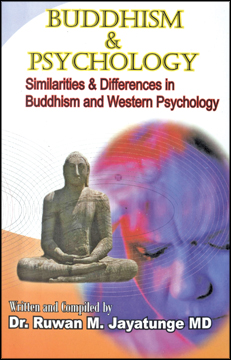|
Focus on Books:
Insights to Buddhism and psychology
Prof. Sunanda MAHENDRA
Book: Buddhism and Psychology
(Similarities and differences in Buddhism and Western Psychology)
Compiler : Dr. Ruwan M Jayatunga MD
Publisher: Atlas
Publishing, Sri Lanka
Page count: 116 ages
Price: Rs.250
At a glance a reader may feel that this work by a medical doctor is
an attempt to expose at length the theoretical and practical aspects as
well as the links that bind Buddhism and psychology.
But the intention it seems is different as this is more of a series
of essays where the broad areas of Buddhism and psychology are
uncovered. The collection of essays run to 12 short chapters where quite
a lot of salient factors are presented. They cover initially the broad
base of Buddhism and psychology, where the two areas are shown as
interlinked.
 Followed by this introductory chapter, the writer /compiler takes a
glimpse at the concept of Nirvana from a psychological point of view
covering such aspects as the significance of meditation drawing examples
from a few sources. As a layman interested in knowing more about these
factors, I felt that the insights to the subject area could have been
broadened. Followed by this introductory chapter, the writer /compiler takes a
glimpse at the concept of Nirvana from a psychological point of view
covering such aspects as the significance of meditation drawing examples
from a few sources. As a layman interested in knowing more about these
factors, I felt that the insights to the subject area could have been
broadened.
The writer/compiler lays down the conclusion that Nirvana is
cognisable by mind, and underlines that human mind can be trained in
higher cognitive functions.
Undoubtedly the training of the mind is the most difficult training
for the humans. The learned compiler may have exposed the reader to the
psychology world of findings as to how it is practised.
I felt that the chapter three which covers the aspects of 'conquering
fear' contains quite a number of factors relating to the topic in
discussion. In a manual-like manner the writer lays down a list of
phobias, which are quite helpful to the reader.
In Buddhist texts, quite a number of references are found pertaining
to the subject of fear. Number of monks who have gone to forest abodes
to meditate have returned to the Buddha due to various fears. The
Buddha, it is recorded, has prescribed certain subjects for meditation
where the fear is made to either eradicated or conquered. This quest
over fear had been the main topic of discussion in several suttas.
The chapter five, which is titled as 'Carl Jung meets Lord Buddha',
is one of the interesting rediscovery on the part of the compiler. He
lays down the details pertaining to Dr. Jung's visit to India and Sri
Lanka, where he had the chance to relocate his vision on the concept of
collective conscience via Buddhist thought.
The most interesting research materials of the subject of
psychological aspects of Jataka stories are recorded in chapter six,
providing various insights to the content in the Jataka tales with
examples drawn to illustrate the age-old subject in terms of modernism.
The writer selects a few examples of Jataka stories to illustrate the
stories had made an attempt to visualise such aspects as stress
disorder, fear of women, sexual inclinations and sexual fantasies,
anti-social personality traits, pathological grief, criminological
behaviours etc.
The writer collates various views and examples as drawn in the past
by scholars such as Dr. D V J Harischandra and learned writers like
Martin Wickramasinghe.
This indeed is a chapter which can go into a lengthy deep study. The
Jataka stories or the past stories of the Buddha are not only edifying
examples which teaches the aspects of Buddhism, but also treatises which
provide creative insights today's behaviour patterns. As such, Jataka
stories are not merely mundane experiences of humans but providers of
examples for more complex situations in the life of humans.
The chapter seven which briefly deals on the links between Marxism
and Buddhism, is an attempt to interpret how the social structure is
observed from two points of view, which ultimately helps a person to
realise that the two entities are interlinked. One is materially bound
and the other is spiritually bound. According to the writer, Marx and
Engels who are responsible for the Communist manifestation have regarded
Buddhism as a philosophy rather than a religion. This is a salient
factor that needs more interpretation.
The writer makes an attempt to trace various forms and structures of
society and pinpoints what the Buddha laid down as essential factors
that go into the moulding of a better society.
He illustrates these factors via the Chakkavatti Sihanada Sutta. In
order to trace the concept of poverty suffering, over production and
even global pollution. An understanding of wealth and honest living
conditions are underlined in the teachings of the Buddha. This then is
yet another chance for a scholar to interpret more on the social
structure as modeled by the Buddha.
Gautama Buddha, the Unique Psychotherapist (chapter nine) is yet
another cluster of material that throws new light on the aspects of
Buddhist doctrine and psychology. But as I see the modern aspects as
declared in psychology than the Buddhist doctrine.
The reader may have gained a lot of knowledge if reference was made
to some of the suttas like Ariya Pariyesana Sutta. But these collections
of notes on the part of the writer enables a new researcher to
rediscover several new paths and bypaths.
[email protected]
|



